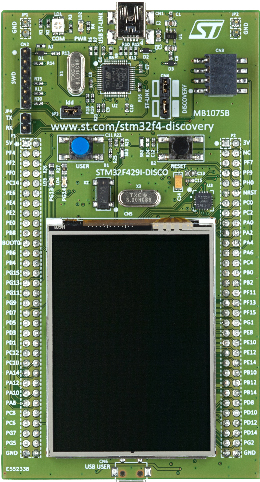ST has announced a new born in the discovery line, based on STM32F429ZIT6 microcontroller, with 64Mbit SDRAM and a QVGA display on board!


ST has announced a new born in the discovery line, based on STM32F429ZIT6 microcontroller, with 64Mbit SDRAM and a QVGA display on board!

Most breadboards are not equipped with a power supply circuit. Every electronic enthusiast uses a breadboard since they are a fundamental tool to develop in a fast and easy way. Some problems arise when we need to work with devices not powered from the USB port or that need other supply voltages than 5V, so I decided to add a simple power supply to my large breadboard.

“Radio-frequency identification (RFID) is the wireless non-contact use of radio-frequency electromagnetic fields to transfer data, for the purposes of automatically identifying and tracking tags attached to objects. The tags contain electronically stored information. Some tags are powered by and read at short ranges (a few meters) via magnetic fields (electromagnetic induction). Others use a local power source such as a battery, or else have no battery but collect energy from the interrogating EM field, and then act as a passive transponder to emit microwaves or UHF radio waves (i.e., electromagnetic radiation at high frequencies). Battery powered tags may operate at hundreds of meters. Unlike a bar code, the tag does not necessarily need to be within line of sight of the reader, and may be embedded in the tracked object.
Gainclone or chipamp is a term commonly used to describe a type of audio amplifier made by do-it-yourselfers, or individuals interested in DIY audio. It is a design based on high-power integrated circuits, particularly the National Semiconductor Overture series. The Gainclone is probably the most commonly built and well-known amplifier project amongst hobbyists. It is simple to build and involves only a few readily accessible, inexpensive parts. As an amplifier it is highly regarded by many in the DIY community. (from wikipedia http://en.wikipedia.org/wiki/Gainclone)
No one can describe the gainclone’s philosophy better than this wikipedia page!
Tha gainclone is an easy-to-built, cheap, hifi quality, simple amplifier made with few components. I’ve decided to create a gainclone version myself, doubling the output power and using the idea from an old application note from National Semiconductor, talking about the parallel amplifier PA100.
The Schumann resonances (SR) are a set of spectrum peaks in the extremely low frequency (ELF) portion of the Earth‘s electromagnetic field spectrum. Schumann resonances are global electromagnetic resonances, excited by lightning discharges in the cavity formed by the Earth’s surface and the ionosphere.
(from Wikipedia http://en.wikipedia.org/wiki/Schumann_resonances)
Schumann resonances are claimed to provide equilibrium between people and Earth, since the main frequency (7.83Hz) has a wavelength of 38000Km (about the circumference of the Earth). Most of scientific community argued that a body small like the human one can’t obtain advantages from this frequency. Despite of this, some audiophiles (in which I also agree) says that when in presence of a Schumann resonance the music listening is more relaxed.
Create a website and earn with Altervista - Disclaimer - Report Abuse - Privacy Policy - Customize advertising tracking